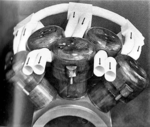Considering the conventional way radials developed,
With the supercharger intakes at the rear of the engine and the exhaust manifolds, on some types at the front (which for these meant turning the exhaust gases through 180 degrees before routing them between the cylinders which affects exhaust flow and more importantly cooling airflow. ........Or the more conventional reverseflow head layout.
Did any engine company try mounting a supercharger on the front of a radial type engine, which would aid in ram air effect, give better crossflow head design and in the case of some particular engines (the radial sleeve valve type) allow a much shorter and less complicated exhaust layout.
Yes the prop reduction gear is in the way, but it forms a bell housing shape so an enlarged one could also house a centrifugal-type blower and all the gear driven accessories could be moved to the rear gearcase.
Any thoughts on it would be appreciated purely out of interest.
I understand some earlier radials that did use a cross-flow type head formed the exhaust manifolds at the front of the engine into circular collector to act as an anti-icing ring on the front of the engine cowling.
As an aside, and purely out of interest as it's off topic: I read an article where there was serious thought given to turning the clutch pressure plate (manual car) into a blower by adding centrifugal blower-type fins to the outer casing of the clutch assembly. Clearly an inner housing would be used to form a pressure chamber.
With the supercharger intakes at the rear of the engine and the exhaust manifolds, on some types at the front (which for these meant turning the exhaust gases through 180 degrees before routing them between the cylinders which affects exhaust flow and more importantly cooling airflow. ........Or the more conventional reverseflow head layout.
Did any engine company try mounting a supercharger on the front of a radial type engine, which would aid in ram air effect, give better crossflow head design and in the case of some particular engines (the radial sleeve valve type) allow a much shorter and less complicated exhaust layout.
Yes the prop reduction gear is in the way, but it forms a bell housing shape so an enlarged one could also house a centrifugal-type blower and all the gear driven accessories could be moved to the rear gearcase.
Any thoughts on it would be appreciated purely out of interest.
I understand some earlier radials that did use a cross-flow type head formed the exhaust manifolds at the front of the engine into circular collector to act as an anti-icing ring on the front of the engine cowling.
As an aside, and purely out of interest as it's off topic: I read an article where there was serious thought given to turning the clutch pressure plate (manual car) into a blower by adding centrifugal blower-type fins to the outer casing of the clutch assembly. Clearly an inner housing would be used to form a pressure chamber.

